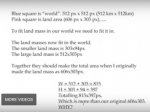Which option or "formula" from below do I use to find the total land area AND WHY? >>>>>PLEASE STATE AND EXPLAIN WHY IT'S USED OVER THE OTHERS<<<<<
find total land area, find percentage of ocean
Known information:
2d map world size = 512 x 512km = 262,144,000,000m2
Continent 1 of 3
28% of total land mass area
192x96km
18,432,000,000m2
a=28%
b=x
c=y
a+b+c=100%
option one:
b+c=100-28
b+c= 72
difference of 28 and 72 = 44
192x0.44+192= 276.48
96x0.44+96= 138.24
total 276.48+192= 468.48
138.24+96= 234.24
468.48x234.24= [109,736,755,200m2]
option two:
72/2 = 36
36-28=8
192x0.08+192=207.36
96x0.08+96=103.68
207.36x2=414.72
103.68x2=207.36
414.72x207.36 = 85,996,339,200 + 18,432,000,000m2 = [104,428,339,200m2]
option 3:
18,432,000,000m2 / .28 = 65,828,571,428m2 + 18,432,000,000m2 = [84,260,571,428m2]
option 4:
difference of 72%
192x0.72+192=330.24
96x0.72+96=165.12
330.24x165.12 = 54,529,228,800 + 18,432,000,000 = [72,961,228,000m2]
option 5:
192km / .28 = 685.71...
96km / .28 = 342.85...
685.71x342.85 = [234,270,000,000m2]
find total land area, find percentage of ocean
Known information:
2d map world size = 512 x 512km = 262,144,000,000m2
Continent 1 of 3
28% of total land mass area
192x96km
18,432,000,000m2
a=28%
b=x
c=y
a+b+c=100%
option one:
b+c=100-28
b+c= 72
difference of 28 and 72 = 44
192x0.44+192= 276.48
96x0.44+96= 138.24
total 276.48+192= 468.48
138.24+96= 234.24
468.48x234.24= [109,736,755,200m2]
option two:
72/2 = 36
36-28=8
192x0.08+192=207.36
96x0.08+96=103.68
207.36x2=414.72
103.68x2=207.36
414.72x207.36 = 85,996,339,200 + 18,432,000,000m2 = [104,428,339,200m2]
option 3:
18,432,000,000m2 / .28 = 65,828,571,428m2 + 18,432,000,000m2 = [84,260,571,428m2]
option 4:
difference of 72%
192x0.72+192=330.24
96x0.72+96=165.12
330.24x165.12 = 54,529,228,800 + 18,432,000,000 = [72,961,228,000m2]
option 5:
192km / .28 = 685.71...
96km / .28 = 342.85...
685.71x342.85 = [234,270,000,000m2]
Last edited:

